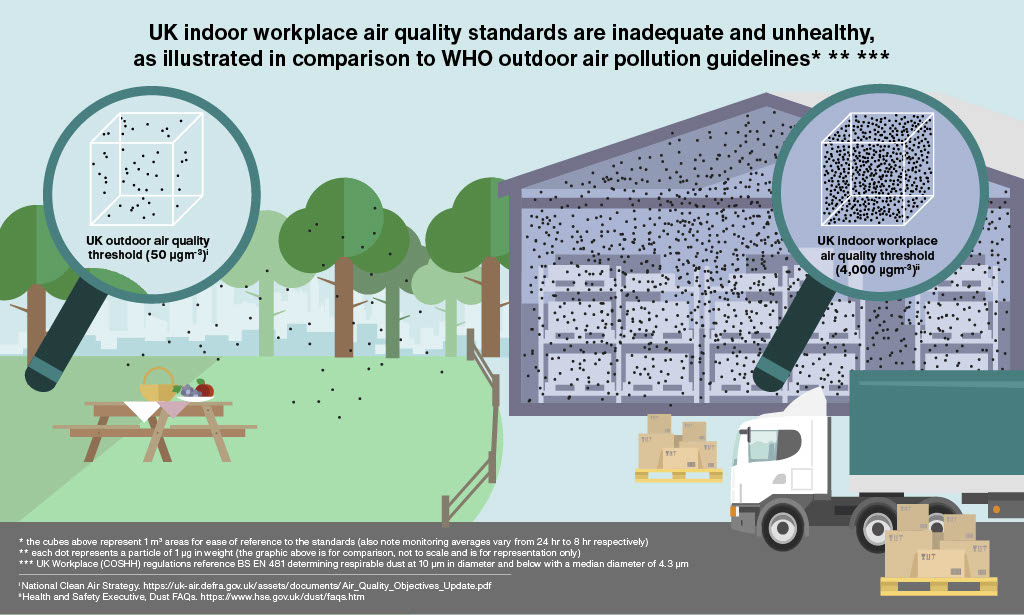indoor air quality
Safety & Health Practitioner
The health and wellbeing of our country’s workforce has never been more important, especially for the hidden heroes working in the manufacturing sector. Indoor air quality is rapidly climbing the boardroom agenda, as all companies continue to make workplaces COVID-19 secure, to minimise the spread of all kinds of respiratory health challenges.
The situation

Désirée Abrahams, Global Action Plan’s Senior Business Engagement Manager
Air pollution is a health crisis and economic burden. Over 12 million residents in the UK are living with health issues that can be exacerbated by air pollution. Three million working days a year are lost because the UK’s air pollution exceeds the World Health Organization’s recommend limits.
Employers in the manufacturing sector face the challenge of protecting the health of three million workers while the very activity inside their factories can sometimes generate harmful air pollutants. Airborne hazards are caused by stonework, cement, spray painting, flour and grain, animal feed, welding and metal work, to name a few. Such hazards can cause new health issues but are especially dangerous to the tens of thousands of manufacturing workers with pre-existing conditions, such as asthma or heart related conditions.
This issue was recently highlighted in the Clean Air Workplaces campaign led by Global Action Plan in partnership with Zehnder Clean Air Solutions, following lack of support to manufacturing workers who continued to work throughout the COVID-19 pandemic. The research which presented a renewed case for tackling air pollution in the manufacturing sector, found 440,000 UK workers with health conditions that can be exacerbated by poor indoor air quality were still being exposed to dangerous levels of airborne pollution indoors.
The pandemic
Whilst 2020 and 2021 have been critical for urgent public health messaging concerning COVID-19, employers have only put in place the bare minimum preventative measures to protect workers. Health and safety protections for workers within industrial settings are needed beyond ventilation to combat COVID-19. Workers need holistic protection, which considers the impact of indoor air pollution on health.
Air pollution and COVID-19 also compound each other’s impact. Health conditions that are caused or worsened by air pollution – such as asthma, heart disease and COPD – can also make a person more vulnerable to complications if they contract the virus.
The pandemic continues to bring air quality and ventilation to the forefront of business priorities, bringing an opportunity to take concerted action on tackling toxic air within workplaces throughout the UK.
The regulation
Despite regulation of 500 airborne hazards by the Health and Safety Executive existing, there is evidence that some permitted levels of pollution cause serious health problems, pointing towards the need for lower exposure limits to protect health.
Current regulation is outdated and does not align with the most up to date research on the impacts toxic air has on workers’ health. The Control of Substances Hazardous to Health (COSHH) Regulations 2002 permit levels of harmful airborne pollutants in indoor settings which are significantly higher than what is considered acceptable in ambient contexts.
The disparity is captured below, which shows the higher concentrations levels of PM10 permitted in indoor workplaces in the UK, compared to the levels permitted in outside settings, adjusting for different time intervals.

(Click to enlarge)
This legal inconsistency is a great concern for UK workers in indoor settings and highlights a clear lack of health and safety legal protections for workers in indoor environments in relation to air quality.
The solution
Current UK regulation allows levels of airborne hazards and pollution that are dangerous to manufacturing workers’ health. In response to new research and renewed concern for respiratory health, we suggest the following recommendations for policymakers, regulators and manufacturers themselves.
- Policy makers should review and lower exposure regulation for air pollutants in the industrial workplace. Sound evidence exists to be certain that lowering the acceptable levels of airborne hazards will significantly improve the health protections for employees in the manufacturing sector.
- Enforcement by regulators should be proactive with more spot checks. Without spot checks of manufacturing sites by regulators, it is highly likely that sites that are unintentionally exposing workers to airborne hazards above the allowable limits will be identified. Authorities will also gain a clearer picture of the actual level of pollution at sites, which in turn will enable authorities to inform the policy on allowable limits.
- Manufacturers and regulators should establish a research programme that combines air quality monitoring in manufacturing sites. A long-term monitoring programme on a representative sample of workplaces would enable the authorities to identify how many workers are exposed to air pollution that risks worsening pre-existing health conditions and causing new ones. For manufacturers, a complete understanding of their individual workplace will enable them to also put in place bespoke and preventative measures.
The moment for change is now. It’s time to build back better and fairer.
Article by Désirée Abrahams, Global Action Plan’s Senior Business Engagement Manager, following over 19 years working on responsible business practice. Organisations she has worked for include International Business Leaders Forum, Mining and Faith Reflections Initiative, Chartered Trading Standards Institute, and several United Nations’ organisations, including UNDESA, UNRISD, UNICEF, ILO and the UN Global Compact Network UK. Most recently she has led the Clean Air Workplaces campaign in partnership with Zehnder Clean Air Solutions.
On demand webinar: Benefits of clean air in indoor working environments
- Role of ventilation in reducing transmission of COVID-19
- Ventilation versus filtration – differences and when to use which one
- Best practice for businesses bringing workers back into offices
- Non-COVID-related issues with air quality in sectors including manufacturing
- WHO recommendations on levels of airborne particulates
- Highlights from the Global Action Plan/Zehnder whitepaper on air quality
Click here to register and listen back, on-demand.
Coronavirus advice for employers
This hub page complies all the latest government coronavirus updates. It includes what you can and cannot do in England, Scotland, Wales and Northern Ireland, workplace advice from multiple sources, including information on welcoming staff back to the workplace and the latest vaccination information.
It also contains a host of useful external links and resources to find further information.

The pandemic presents an opportunity to push for new indoor air quality regulation for workers
The health and wellbeing of our country’s workforce has never been more important, especially for the hidden heroes working in the manufacturing sector. Indoor air quality is rapidly climbing the boardroom agenda, as all companies continue to make workplaces COVID-19 secure, to minimise the spread of all kinds of respiratory health challenges.
Safety & Health Practitioner
SHP – Health and Safety News, Legislation, PPE, CPD and Resources
Related Topics
10 Years On: The Role of the Duty Holder/Client
Dr Mavis Nye named SHP’s Most Influential person in health & safety for 2021
Coronavirus advice for employers
[ad_2]
Originally Appeared Here